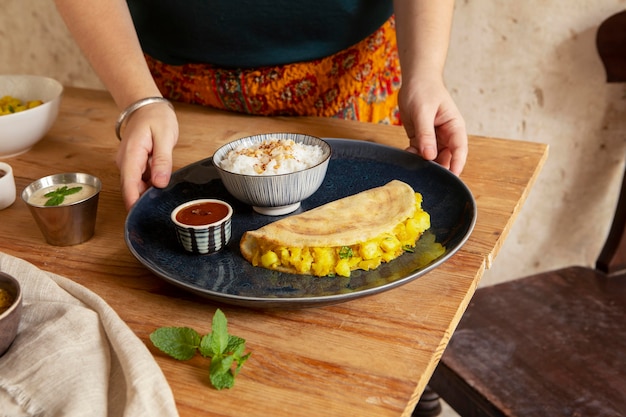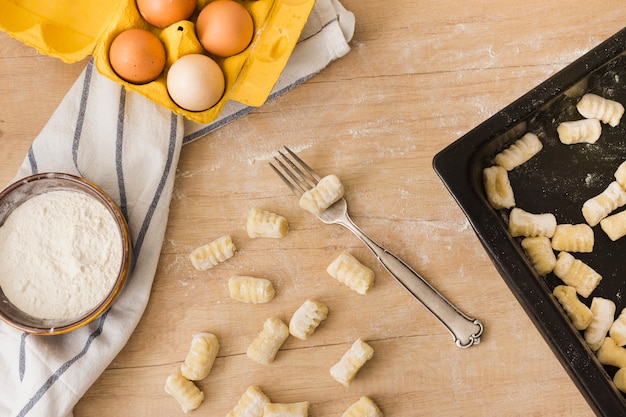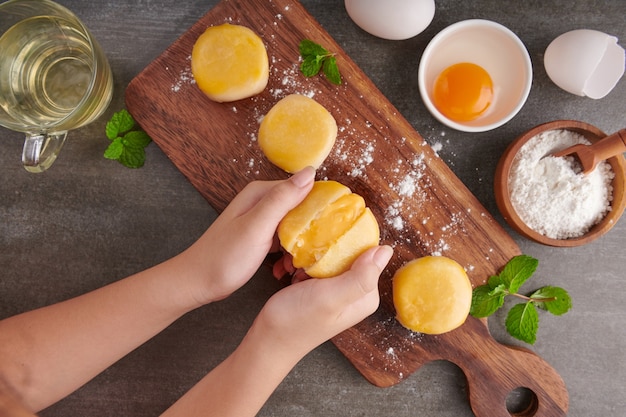(Part 1) Choosing the Right Cornmeal: The Foundation of Flavour

1. Coarse Cornmeal: The Hearty Friend
This is the classic choice for traditional polenta. It has a rougher texture and a slightly rustic feel. Think of it as the hearty friend who's always up for a good time. Coarse cornmeal is perfect for recipes that call for a robust texture and a lovely, crunchy crust. It's like that comforting hug on a cold night, you just can't get enough of it!
2. fine cornmeal: The Smooth Operator
Fine cornmeal is the refined, smooth option. It creates a silky polenta that's ideal for creamy sauces and delicate dishes. Think of it as the sophisticated friend who always knows how to dress up for a night out. It's perfect for recipes like creamy corn soup, polenta cakes, or those elegant, melt-in-your-mouth dishes.
3. Instant Cornmeal: The Lifesaver
Let's be honest, we all have those nights when we're absolutely knackered and the last thing we want is to fuss in the kitchen. This is where instant cornmeal comes in. It cooks in a flash, and while it might not have the most complex flavour, it's a total lifesaver for busy nights.
Tip: The Power of Blending
Don't be afraid to experiment with different types of cornmeal to find your perfect blend. For a classic Italian polenta, a mix of coarse and fine cornmeal is often used to achieve that perfect balance of texture - a bit of heartiness with a touch of elegance.
(Part 2) The Art of Cooking Polenta: Mastering the Basics

1. The Golden Ratio: Finding Balance
For every cup of cornmeal, use about 4 cups of water or broth. This ratio gives you a beautiful, creamy consistency. Want a thicker polenta? Reduce the liquid slightly. Prefer a thinner, more saucy polenta? Increase the liquid a bit. It's all about finding your personal preference.
2. The Whisking Ritual: Preventing Clumps
Slowly whisk the cornmeal into the boiling liquid. This is crucial for preventing clumps from forming and creating a smooth, even texture. Think of it like a calming meditation – slow, steady, and controlled. It's surprisingly soothing!
3. The Simmer Down: Cooking to Perfection
Once the polenta starts to thicken, reduce the heat to a simmer and cook for around 15-20 minutes, stirring occasionally. This allows the cornmeal to cook thoroughly and absorb the liquid, creating that lovely, creamy texture. Be patient, it's worth the wait.
4. The Seasoning Savvy: Flavour from the Inside Out
Salt is your best friend. Season the water or broth generously before adding the cornmeal. This infuses the polenta with flavour from the very beginning. Think of it like seasoning pasta water - it makes all the difference.
5. The Smoothing Out: Eliminating Lumps
To ensure a perfectly smooth polenta, use a potato masher or an immersion blender to smooth out any lumps after cooking. Don't be afraid to get a little messy here, it's all part of the process.
(Part 3) Polenta: The Creative Canvas for Culinary Exploration

1. The Classic Italian Polenta: Simple Elegance
A true Italian classic, served with simple but delicious ingredients like sautéed mushrooms, melted butter, and grated Parmesan cheese. It's a dish that's both comforting and incredibly satisfying. You'll find yourself making it again and again.
2. The Creamy Corn Soup: Light and Delicious
A lighter and more refreshing way to enjoy polenta. Blend cooked polenta with some milk or cream, then add your favourite vegetables and seasonings. It's the perfect meal for a chilly evening or a light lunch.
3. The Polenta Cakes: Mini Masterpieces
Imagine mini polenta pizzas, bursting with flavour. Get creative with your toppings - cheese, vegetables, herbs, the possibilities are endless. They're fantastic as a starter or a light lunch.
4. The Stuffed Polenta: A Delicious Vessel
Think of polenta as a vessel for all sorts of delicious fillings. Try stuffing it with mushrooms, spinach, or even leftover roast chicken. It's a real crowd-pleaser, especially for a casual dinner party.
5. The Polenta Bake: Hearty and Comforting
This is a great way to use up leftover polenta. Layer it in a baking dish with cheese, vegetables, and herbs. It's a hearty and comforting dish perfect for a cozy dinner.
(Part 4) Polenta Tips: The Insider's Secrets for Success
Now, let's delve into those little tricks I've learned over the years.1. Embrace the Stickiness: It's Part of the Charm
Polenta can be a bit sticky, but that's part of its charm. Just make sure you use a non-stick pan and stir it regularly. A little bit of butter or olive oil will also help prevent sticking.
2. The Power of Resting: Allowing It to Set
Once you've cooked your polenta, let it rest for about 10 minutes before serving. This allows the polenta to set and become more firm, making it easier to handle and slice.
3. Keeping It Warm: Preserving the Flavor
Polenta is best served warm, so if you're making it ahead of time, keep it warm in a slow cooker or a low oven. You can also transfer it to a heatproof container and microwave it for a few seconds before serving.
4. The Art of Leftovers: Making the Most of It
Polenta is great for leftovers. Store it in an airtight container in the refrigerator for up to 3 days. You can reheat it in the microwave or on the stovetop. And if you have a lot of leftover polenta, you can always bake it into a delicious casserole.
5. Go Beyond the Usual: Embrace Experimentation
Don't be afraid to experiment with different flavours and toppings. Polenta is a blank canvas, so be creative! You can add things like pesto, roasted vegetables, or even a dollop of sour cream or yogurt.
(Part 5) Beyond the Basics: Exploring Polenta Variations
Now, let's talk about the fun stuff - the endless variations of polenta. Here are a few ideas to get your creative juices flowing:1. Polenta with wild mushrooms: A Taste of Luxury
This is a simple but luxurious dish. Use a mix of wild mushrooms, sautéed in butter with garlic and herbs. Spoon the polenta onto a plate and top with the mushrooms. A sprinkle of Parmesan cheese adds that extra touch of magic.
2. Polenta with smoked salmon and Dill: A Taste of the Sea
For a taste of the sea, try this combination. Top your polenta with thinly sliced smoked salmon, a sprinkle of fresh dill, and a squeeze of lemon juice. A dollop of crème fraiche or sour cream is a lovely touch.
3. Spicy Polenta with Chorizo and Peppers: A Touch of Heat
For a touch of heat, try this. Fry some chorizo sausage with chopped peppers, onions, and garlic. Add a pinch of smoked paprika and some chili flakes for extra kick. Serve the polenta with a generous spoonful of the chorizo mixture.
4. Sweet Polenta: Unexpected Delights
Yes, you read that right! Polenta can be sweet too. Try topping it with fruit, honey, or a drizzle of maple syrup. You can even add a pinch of cinnamon or nutmeg for extra flavour.
5. Polenta with Pesto: Simple and Delicious
A simple but delicious combination. Make your own pesto or use store-bought. Spoon the polenta onto a plate, drizzle with pesto, and top with a sprinkle of Parmesan cheese.
(Part 6) Polenta with a Twist: Creative Recipes for Every Occasion
Let's move onto some recipes that go beyond the traditional. These are perfect for showcasing the versatility of polenta and impressing your guests.1. Polenta with Roasted Vegetables: A Hearty and Colourful Dish
This is a hearty and colourful dish perfect for a weeknight dinner. Roast your favourite vegetables, like sweet potatoes, bell peppers, and onions, then toss them with herbs and spices. Serve the polenta topped with the roasted vegetables.
2. Polenta with Sausage and Spinach: A Classic Combination
This is a classic combination that's always a hit. Brown some italian sausage with onions and garlic. Add a handful of spinach and let it wilt down. Serve the polenta topped with the sausage and spinach mixture.
3. Polenta with Mushrooms and Parmesan: Simple Elegance
This is a simple yet elegant dish perfect for a special occasion. Sauté some mushrooms with garlic and herbs. Then, stir in some heavy cream and Parmesan cheese until melted and bubbly. Serve the polenta topped with the mushroom sauce.
4. Polenta with Black Truffles: Decadent Indulgence
This is a luxurious and decadent dish that's sure to impress. Shave some black truffles over the cooked polenta and serve immediately. A sprinkle of Parmesan cheese adds an extra layer of flavour.
5. Polenta with Gorgonzola and Walnuts: Rich and Flavourful
This is a rich and flavourful dish perfect for a winter evening. Stir some crumbled Gorgonzola cheese into the cooked polenta. Top with toasted walnuts and a sprinkle of fresh thyme.
(Part 7) Polenta for the Busy Cook: Making it Ahead for Convenience
Life gets busy, we all know it. That's why knowing how to make polenta ahead of time is a lifesaver.1. The Freezer Friend: Stock Up for Later
You can freeze cooked polenta for later use. Simply spread it in a single layer on a baking sheet and freeze until solid. Once frozen, transfer the polenta to an airtight container or freezer bag. To use, defrost overnight in the refrigerator or thaw in the microwave.
2. The Overnight Trick: Smoother Texture
For a smoother polenta, let it rest in the fridge overnight. The polenta will firm up, making it easier to slice or serve in various ways.
3. The Slow Cooker Savior: Effortless Cooking
If you're making a large batch of polenta, a slow cooker is your best friend. You can cook the polenta in the slow cooker on low heat for several hours, ensuring a perfectly creamy and consistent texture.
(Part 8) FAQs: Your Polenta Questions Answered
Now, let's tackle those lingering questions you might have about polenta.1. What is polenta?
Polenta is a dish made from coarsely ground cornmeal. It's a staple in Italian cuisine and is often served as a side dish, but it can also be the base for various creative dishes.
2. Is polenta gluten-free?
Yes, polenta is naturally gluten-free. It's made from corn, which is a gluten-free grain. However, be sure to check the label of any pre-made polenta or polenta mixes, as some might contain added ingredients that contain gluten.
3. How do I make polenta creamy?
The key to creamy polenta is to use good quality cornmeal and to cook it slowly, stirring frequently. You can also add a little bit of butter or cream to the polenta while it's cooking.
4. How long can I store polenta in the fridge?
Cooked polenta can be stored in an airtight container in the refrigerator for up to 3 days.
5. What are some good toppings for polenta?
Polenta is incredibly versatile and can be topped with various ingredients. Some popular toppings include mushrooms, cheese, roasted vegetables, pesto, and sausage.
And there you have it, folks, a comprehensive guide to the wonderful world of polenta. Now, go forth and create some deliciousness! I promise, you won't regret it. And if you have any questions, feel free to ask in the comments below. Let's make some culinary magic happen together!Everyone is watching

Prime Rib Roast Cooking Time Chart: Per Pound Guide
Cooking TipsPrime rib roast. Just the name conjures images of lavish dinners, crackling fires, and hearty laughter. It’s ...

How Long to Bake Potatoes in the Oven (Perfect Every Time)
Cooking TipsBaked potatoes are a staple in my kitchen. They're incredibly versatile, delicious, and surprisingly easy to m...

Perfect Rice Every Time: The Ultimate Guide to Cooking Rice
Cooking TipsAs a self-proclaimed foodie, I've always been a bit obsessed with rice. It's the foundation of countless cuisi...

The Ultimate Guide to Cooking Asparagus: Tips, Techniques, and Recipes
Cooking TipsAsparagus. The mere mention of this spring delicacy conjures up images of vibrant green spears, crisp and burs...

Ultimate Guide to Cooking the Perfect Thanksgiving Turkey
Cooking TipsThanksgiving. Just the word conjures up images of overflowing tables laden with delicious food, the scent of r...
